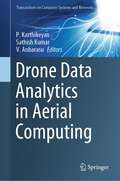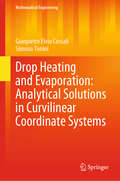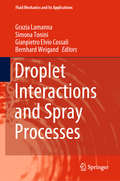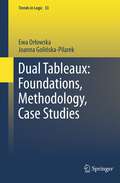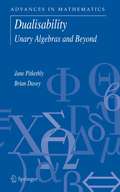- Table View
- List View
Driving Devops With Value Stream Management: Improve It Value Stream Delivery With A Proven Vsm Methodology To Compete In The Digital Economy
by Cecil 'Gary' Rupp Helen BealImprove IT value stream delivery with a proven VSM methodology to compete in the digital economy
Drone Data Analytics in Aerial Computing (Transactions on Computer Systems and Networks)
by P. Karthikeyan Sathish Kumar V. AnbarasuThis book discusses the latest research, theoretical, and experimental research innovations in drone data analytics in aerial computing. Drone data analytics guarantees that the right people have the correct data at their fingertips whenever they need it. The contents also discuss the challenges faced with drone data analytics, such as due to the high mobility of drones, aerial computing is significantly different from terrestrial computing. It also includes case studies from leading drone vendors. The book also focuses on the comparison of data management and security mechanisms in drone data analytics. This book is useful to those working in agriculture, mining, waste management, and defenses department.
Drop Heating and Evaporation: Analytical Solutions in Curvilinear Coordinate Systems (Mathematical Engineering)
by Gianpietro Elvio Cossali Simona ToniniThis book describes analytical methods for modelling drop evaporation, providing the mathematical tools needed in order to generalise transport and constitutive equations and to find analytical solutions in curvilinear coordinate systems. Transport phenomena in gas mixtures are treated in considerable detail, and the basics of differential geometry are introduced in order to describe interface-related transport phenomena. One chapter is solely devoted to the description of sixteen different orthogonal curvilinear coordinate systems, reporting explicitly on the forms of their differential operators (gradient, divergent, curl, Laplacian) and transformation matrices. The book is intended to guide the reader from mathematics, to physical descriptions, and ultimately to engineering applications, in order to demonstrate the effectiveness of applied mathematics when properly adapted to the real world. Though the book primarily addresses the needs of engineering researchers, it will also benefit graduate students.
Droplet Interactions and Spray Processes (Fluid Mechanics and Its Applications #121)
by Grazia Lamanna Simona Tonini Gianpietro Elvio Cossali Bernhard WeigandThis book provides a selection of contributions to the DIPSI workshop 2019 (Droplet Impact Phenomena & Spray Investigations) as well as recent progress of the Int. Research Training Group “DROPIT”.The DIPSI workshop, which is now at its thirteenth edition, represents an important opportunity to share recent knowledge on droplets and sprays in a variety of research fields and industrial applications. The research training group “DROPIT” is focused on droplet interaction technologies where microscopic effects influence strongly macroscopic behavior. This requires the inclusion of interface kinetics and/or a detailed analysis of surface microstructures. Normally, complicated technical processes cover the underlying basic mechanisms, and therefore, progress in the overall process modelling can hardly be gained. Therefore, DROPIT focuses on the underlying basic processes. This is done by investigating different spatial and/or temporal scales of the problems and by linking them through a multi-scale approach. In addition, multi-physics are required to understand e.g. problems for droplet-wall interactions, where porous structures are involved.
Drug Delivery Approaches: Perspectives from Pharmacokinetics and Pharmacodynamics
by Bret BernerExplore this comprehensive discussion of the application of physiologically- and physicochemical-based models to guide drug delivery edited by leading experts in the field Drug Delivery Approaches: Perspectives from Pharmacokinetics and Pharmacodynamics delivers a thorough discussion of drug delivery options to achieve target profiles and approaches as defined by physical and pharmacokinetic models. The book offers an overview of drug absorption and physiological models, chapters on oral delivery routes with a focus on both PBPK and multiple dosage form options. It also provides an explanation of the pharmacokinetics of the formulation of drugs delivered by systemic transdermal routes. The distinguished editors have included practical and accessible resources that address the biological and delivery approaches to pulmonary and mucosal delivery of drugs. Emergency care settings are also described, with explorations of the relationship between parenteral infusion profiles and PK/PD. The future of drug delivery is addressed via discussions of virtual experiments to elucidate mechanisms and approaches to drug delivery and personalized medicine. Readers will also benefit from the inclusion of: A thorough introduction to the utility of mathematical models in drug development and delivery An exploration of the techniques and applications of physiologically based models to drug delivery Discussions of oral delivery and pharmacokinetic models and oral site-directed delivery A review of integrated transdermal delivery and pharmacokinetics in development An examination of virtual experiment methods for integrating pharmacokinetic, pharmacodynamic, and drug delivery mechanisms Alternative endpoints to pharmacokinetics for topical delivery Perfect for researchers, industrial scientists, graduate students, and postdoctoral students in the area of pharmaceutical science and engineering, Drug Delivery Approaches: Perspectives from Pharmacokinetics and Pharmacodynamics will also earn a place in the libraries of formulators, pharmacokineticists, and clinical pharmacologists.
Drug Delivery Approaches: Perspectives from Pharmacokinetics and Pharmacodynamics
by Bret Berner Heather A. E. Benson Michael S. Roberts Toufigh GordiExplore this comprehensive discussion of the application of physiologically- and physicochemical-based models to guide drug delivery edited by leading experts in the field Drug Delivery Approaches: Perspectives from Pharmacokinetics and Pharmacodynamics delivers a thorough discussion of drug delivery options to achieve target profiles and approaches as defined by physical and pharmacokinetic models. The book offers an overview of drug absorption and physiological models, chapters on oral delivery routes with a focus on both PBPK and multiple dosage form options. It also provides an explanation of the pharmacokinetics of the formulation of drugs delivered by systemic transdermal routes. The distinguished editors have included practical and accessible resources that address the biological and delivery approaches to pulmonary and mucosal delivery of drugs. Emergency care settings are also described, with explorations of the relationship between parenteral infusion profiles and PK/PD. The future of drug delivery is addressed via discussions of virtual experiments to elucidate mechanisms and approaches to drug delivery and personalized medicine. Readers will also benefit from the inclusion of: A thorough introduction to the utility of mathematical models in drug development and delivery An exploration of the techniques and applications of physiologically based models to drug delivery Discussions of oral delivery and pharmacokinetic models and oral site-directed delivery A review of integrated transdermal delivery and pharmacokinetics in development An examination of virtual experiment methods for integrating pharmacokinetic, pharmacodynamic, and drug delivery mechanisms Alternative endpoints to pharmacokinetics for topical delivery Perfect for researchers, industrial scientists, graduate students, and postdoctoral students in the area of pharmaceutical science and engineering, Drug Delivery Approaches: Perspectives from Pharmacokinetics and Pharmacodynamics will also earn a place in the libraries of formulators, pharmacokineticists, and clinical pharmacologists.
Drug Development for Rare Diseases (Chapman & Hall/CRC Biostatistics Series)
by Yang BoA disease is defined as rare if the prevalence is fewer than 200,000 in the United States. It is estimated that there are more than 7,000 rare diseases, which collectively affect 30 million Americans or 10% of the US population. This diverse and complex disease area poses challenges for patients, caregivers, regulators, drug developers, and other stakeholders. This book is proposed to give an overview of the common issues facing rare disease drug developers, summarize challenges specific to clinical development in small populations, discuss drug development strategies in the evolving regulatory environment, explain generation and utilization of different data and evidence inside and beyond clinical trials, and use recent examples to demonstrate these challenges and the development strategies that respond to the challenges. Key Features: • Rare disease. • Drug development. • Innovative clinical trial design. • Regulatory approval. • Real-world evidence.
Drug Development for Rare Diseases (Chapman & Hall/CRC Biostatistics Series)
by Bo Yang Yang Song Yijie ZhouA disease is defined as rare if the prevalence is fewer than 200,000 in the United States. It is estimated that there are more than 7,000 rare diseases, which collectively affect 30 million Americans or 10% of the US population. This diverse and complex disease area poses challenges for patients, caregivers, regulators, drug developers, and other stakeholders. This book is proposed to give an overview of the common issues facing rare disease drug developers, summarize challenges specific to clinical development in small populations, discuss drug development strategies in the evolving regulatory environment, explain generation and utilization of different data and evidence inside and beyond clinical trials, and use recent examples to demonstrate these challenges and the development strategies that respond to the challenges. Key Features: • Rare disease. • Drug development. • Innovative clinical trial design. • Regulatory approval. • Real-world evidence.
Drug Epidemiology and Post-Marketing Surveillance (Nato Science Series A: #224)
by Brian L. Strom G. P. VeloThis volume is a summary of material presented in the course given in the International School of Phannacology on "Drug Epidemiology and Post-Marketing Surveillance" between September 27 and October 8, 1990, at the "Ettore Majorana Center for Scientific Culture" in Erice, Sicily. The course, which was a NATO Advanced Study Institute, included lectures and workshops presented by experts in the new field of phannacoepidemiology. The material covered includes various approaches to spontaneous reporting of adverse drug reactions, including aggregate approaches, such as those used in France, and detailed analyses of individual reports, such as that done in The Netherlands and in Sweden. Also, included are studies using traditional epidemiology methods. In addition, modern pharmacoepidemiology makes considerable use of automated databases. As such, information is presented on their use as well. Phannacoepidemiology started in hospitals and some of the newest work in the field is returning to the hospital as a site for studies. Material on these topics was presented as well. Finally, selected new methodologic developments were outlined in specific examples presented that were of regulatory and commercial importance. This new field of phannacoepidemiology is exploding in interest internationally. Evidence of this is the increasing development of pharmacoepidemiology programs in industry, medical schools, pharmacy schools, and schools of public health. Also, there is a new International Society ofPhannacoepidemiology. Practitioners in this field tend to specialize in either analyses of spontaneous reporting or the use of formal epidemiologic techniques.
Drug offence arrests by age group (large print)
by RnibThis page shows a bar chart. There is a locator dot shown, which will be at the top left, when the image is the correct way up. The chart shows the number of arrests by age group. The Y-axis on the left of the page is the number of arrests in hundreds. Along the X-axis, boys are on the left and girls are on the right, each in two age groups. There is a small key at the top right of the page.
Drug offence arrests by age group (UEB contracted)
by RnibThis page shows a bar chart. There is a locator dot shown, which will be at the top left, when the image is the correct way up. The chart shows the number of arrests by age group. The Y-axis on the left of the page is the number of arrests in hundreds. Along the X-axis, boys are on the left and girls are on the right, each in two age groups. There is a small key at the top right of the page.
Drug offence arrests by age group (UEB uncontracted)
by RnibThis page shows a bar chart. There is a locator dot shown, which will be at the top left, when the image is the correct way up. The chart shows the number of arrests by age group. The Y-axis on the left of the page is the number of arrests in hundreds. Along the X-axis, boys are on the left and girls are on the right, each in two age groups. There is a small key at the top right of the page.
Drugspeak: The Analysis of Drug Discourse
by John Booth DaviesDrugspeak The Analysis of Drug Discourse describes the way in which conversations between drug users vary and change according to context and circumstance in ways that suggest that there is no single truth about the state we call addicted. The central thesis of the book is that the explanations that drug users give for their drug use make sense not so much as sources of facts, but as primarily functional statements shaped by a climate of moral and legal censure. Consequently the significance of drug conversations lies not in their literal semantics but in the purposes such conversations serve. The argument raises a number of fundamental issues about the performative rather than the informative nature of language, about the nature of the scientific facts concerning drug use, and about the very nature of science itself. Starting with a general overview of the problems arising from a mechanistic and deterministic view of science, the book identifies a need for a new approach to the un
Drugspeak: The Analysis of Drug Discourse
by John Booth DaviesDrugspeak The Analysis of Drug Discourse describes the way in which conversations between drug users vary and change according to context and circumstance in ways that suggest that there is no single truth about the state we call addicted. The central thesis of the book is that the explanations that drug users give for their drug use make sense not so much as sources of facts, but as primarily functional statements shaped by a climate of moral and legal censure. Consequently the significance of drug conversations lies not in their literal semantics but in the purposes such conversations serve. The argument raises a number of fundamental issues about the performative rather than the informative nature of language, about the nature of the scientific facts concerning drug use, and about the very nature of science itself. Starting with a general overview of the problems arising from a mechanistic and deterministic view of science, the book identifies a need for a new approach to the un
The Drunkard's Walk: How Randomness Rules Our Lives
by Leonard MlodinowAn exhilarating, eye-opening guide to understanding our random worldLeonard Mlodinow reveals the psychological illusions that prevent us understanding everything from stock-picking to wine-tasting, winning the lottery to road safety, and reveals the truth about the success of sporting heroes and film stars, and even how to make sense of a blood test.The Drunkard's Walk is an exhilarating, eye-opening guide to understanding our random world - read it, so you won't be left a victim of chance.Leonard Mlodinow has a Ph.D., has been a member of the faculty of the California Institute of Technology and a television writer in Hollywood, as well as developing many award winning CD-Roms. He is currently Vice President of Emerging Technologies and R&D at Scholastic Inc. and lives in New York City. His previous books include A Brief History of Time, which he co-authored, and Euclid's Window and Some Time with Feynman both published by Penguin.
DSGE Models for Real Business Cycle and New Keynesian Macroeconomics: Theoretical Methods and Numerical Solutions with DYNARE (Springer Texts in Business and Economics)
by Giuseppe ChirichielloThis textbook introduces graduate and upper undergraduate students to Dynamic Stochastic General Equilibrium (DSGE) models. As DSGE models become integral in advanced coursework, this book serves as an invaluable guide, explaining the complexities with a methodological red thread across its five chapters. Starting with the stochastic dynamic models of the Real Business Cycle (RBC) and progressing through the field of New Keynesian Macroeconomics (NKE), it employs DSGE models to shed light on the dynamic nature of economic systems.The book presents the Blanchard-Kahn methodology for theoretical solutions, discussing its usefulness and limitations as models evolve in complexity. The book goes on to explain the shift from analytical to numerical solutions, showcasing the DYNARE software and providing coding insights. Unique to this volume is a chapter on difference equations, equipping students with essential mathematical tools, and a concluding exploration of a medium-sized NewKeynesian Economics model.This book will equip students to navigate the theoretical complexities of the topic and to independently replicate and comprehend the presented results. It bridges the gap between classical and Keynesian paradigms, reviving the debate in today's "RBC vs NKE" landscape. It will enable students to master the essence of macroeconomic theories and methodologies, paving the way for their scholarly pursuits.
Dual-Feasible Functions for Integer Programming and Combinatorial Optimization: Basics, Extensions and Applications (EURO Advanced Tutorials on Operational Research)
by Cláudio Alves Francois Clautiaux José Valério de Carvalho Jürgen RietzThis book provides a postgraduate audience the keys they need to understand and further develop a set of tools for the efficient computation of lower bounds and valid inequalities in integer programs and combinatorial optimization problems. After discussing the classical approaches described in the literature, the book addresses how to extend these tools to other non-standard formulations that may be applied to a broad set of applications. Examples are provided to illustrate the underlying concepts and to pave the way for future contributions.
Dual Jet Geometrization for Time-Dependent Hamiltonians and Applications (Synthesis Lectures on Mathematics & Statistics)
by Mircea Neagu Alexandru OanăThis book studies a category of mathematical objects called Hamiltonians, which are dependent on both time and momenta. The authors address the development of the distinguished geometrization on dual 1-jet spaces for time-dependent Hamiltonians, in contrast with the time-independent variant on cotangent bundles. Two parts are presented to include both geometrical theory and the applicative models: Part One: Time-dependent Hamilton Geometry and Part Two: Applications to Dynamical Systems, Economy and Theoretical Physics. The authors present 1-jet spaces and their duals as appropriate fundamental ambient mathematical spaces used to model classical and quantum field theories. In addition, the authors present dual jet Hamilton geometry as a distinct metrical approach to various interdisciplinary problems.
The Dual of L∞: A Primer (SpringerBriefs in Mathematics)
by John TolandIn measure theory, a familiar representation theorem due to F. Riesz identifies the dual space Lp(X,L,λ)* with Lq(X,L,λ), where 1/p+1/q=1, as long as 1 ≤ pL∞(X,L,λ)* cannot be similarly described, and is instead represented as a class of finitely additive measures.This book provides a reasonably elementary account of the representation theory of L∞(X,L,λ)*, examining pathologies and paradoxes, and uncovering some surprising consequences. For instance, a necessary and sufficient condition for a bounded sequence in L∞(X,L,λ) to be weakly convergent, applicable in the one-point compactification of X, is given.With a clear summary of prerequisites, and illustrated by examples including L∞(Rn) and the sequence space l∞, this book makes possibly unfamiliar material, some of which may be new, accessible to students and researchers in the mathematical sciences.
Dual Phase Evolution: From Theory To Practice
by David G. Green Jing Liu Hussein A. AbbassThe aim of the book is to lay out the foundations and provide a detailed treatment of the subject. It will focus on two main elements in dual phase evolution: the relationship between dual phase evolution and other phase transition phenomena and the advantages of dual phase evolution in evolutionary computation and complex adaptive systems. The book will provide a coherent picture of dual phase evolution that encompasses these two elements and frameworks, methods and techniques to use this concept for problem solving.
Dual Quaternions and Their Associated Clifford Algebras
by Ronald GoldmanClifford algebra for dual quaternions has emerged recently as an alternative to standard matrix algebra as a computational framework for computer graphics. This book presents dual quaternions and their associated Clifford algebras in a new light, accessible to and geared toward the computer graphics community. Collecting all the associated formulas and theorems in one place, this book provides an extensive and rigorous treatment of dual quaternions, as well as showing how two models of Clifford algebra emerge naturally from the theory of dual quaternions. Each section comes complete with a set of exercises to help readers sharpen and practice their understanding. This book is accessible to anyone with a basic knowledge of quaternion algebra and is of particular use to forward-thinking members of the computer graphics community.
Dual Quaternions and Their Associated Clifford Algebras
by Ronald GoldmanClifford algebra for dual quaternions has emerged recently as an alternative to standard matrix algebra as a computational framework for computer graphics. This book presents dual quaternions and their associated Clifford algebras in a new light, accessible to and geared toward the computer graphics community. Collecting all the associated formulas and theorems in one place, this book provides an extensive and rigorous treatment of dual quaternions, as well as showing how two models of Clifford algebra emerge naturally from the theory of dual quaternions. Each section comes complete with a set of exercises to help readers sharpen and practice their understanding. This book is accessible to anyone with a basic knowledge of quaternion algebra and is of particular use to forward-thinking members of the computer graphics community.
Dual Tableaux: Foundations, Methodology, Case Studies (Trends in Logic #33)
by Ewa Orlowska Joanna Golińska PilarekThis book presents logical foundations of dual tableaux together with a number of their applications both to logics traditionally dealt with in mathematics and philosophy (such as modal, intuitionistic, relevant, and many-valued logics) and to various applied theories of computational logic (such as temporal reasoning, spatial reasoning, fuzzy-set-based reasoning, rough-set-based reasoning, order-of magnitude reasoning, reasoning about programs, threshold logics, logics of conditional decisions). The distinguishing feature of most of these applications is that the corresponding dual tableaux are built in a relational language which provides useful means of presentation of the theories. In this way modularity of dual tableaux is ensured. We do not need to develop and implement each dual tableau from scratch, we should only extend the relational core common to many theories with the rules specific for a particular theory.
Dual Variational Approach to Nonlinear Diffusion Equations (Progress in Nonlinear Differential Equations and Their Applications #102)
by Gabriela MarinoschiThis monograph explores a dual variational formulation of solutions to nonlinear diffusion equations with general nonlinearities as null minimizers of appropriate energy functionals. The author demonstrates how this method can be utilized as a convenient tool for proving the existence of these solutions when others may fail, such as in cases of evolution equations with nonautonomous operators, with low regular data, or with singular diffusion coefficients. By reducing it to a minimization problem, the original problem is transformed into an optimal control problem with a linear state equation. This procedure simplifies the proof of the existence of minimizers and, in particular, the determination of the first-order conditions of optimality. The dual variational formulation is illustrated in the text with specific diffusion equations that have general nonlinearities provided by potentials having various stronger or weaker properties. These equations can represent mathematical models to various real-world physical processes. Inverse problems and optimal control problems are also considered, as this technique is useful in their treatment as well.
Dualisability: Unary Algebras and Beyond (Advances in Mathematics #9)
by Jane G. Pitkethly Brian A. DaveyNatural duality theory is one of the major growth areas within general algebra. This text provides a short path to the forefront of research in duality theory. It presents a coherent approach to new results in the area, as well as exposing open problems. Unary algebras play a special role throughout the text. Individual unary algebras are relatively simple and easy to work with. But as a class they have a rich and complex entanglement with dualisability. This combination of local simplicity and global complexity ensures that, for the study of natural duality theory, unary algebras are an excellent source of examples and counterexamples. A number of results appear here for the first time. In particular, the text ends with an appendix that provides a new and definitive approach to the concept of the rank of a finite algebra and its relationship with strong dualisability.

